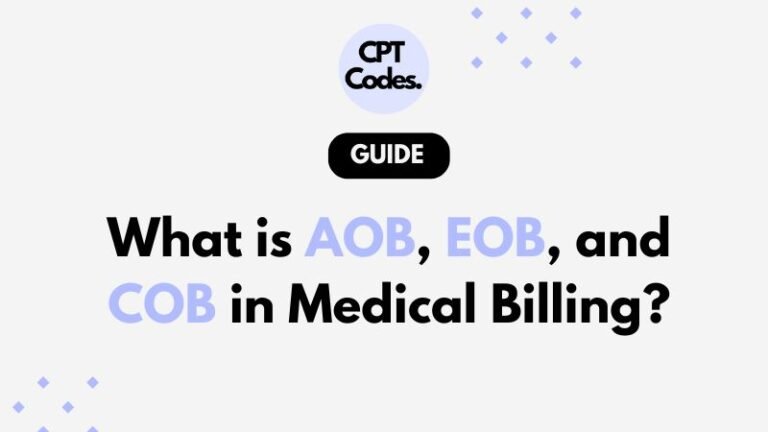Understanding the key terms AOB, EOB, and COB is essential in medical billing. These abbreviations represent important documents and processes that ensure correct claim submission and payment between healthcare providers, patients, and insurance companies.

What Does AOB Mean in Medical Billing?
AOB stands for Assignment of Benefits.
It is a document that allows a healthcare provider to receive payment directly from the patient’s insurance company.
When a patient signs an AOB form, they authorize their insurance provider to send the reimbursement directly to the doctor, hospital, or clinic — instead of paying the patient first.
Why Is AOB Important?
- It reduces payment delays for providers.
- It simplifies the billing process for patients.
- It ensures insurance claims are processed directly between provider and payer.
Without an AOB, the patient might have to pay upfront and wait for reimbursement.
What Is EOB in Medical Billing?
EOB means Explanation of Benefits.
It is a statement sent by the insurance company to the patient (and sometimes to the provider) after a medical claim is processed.
The EOB is not a bill — it’s a detailed summary explaining:
- What medical services were covered
- How much the insurance paid
- What amount the patient owes (if any)
Example:
If a doctor bills $500 for a procedure and insurance covers $400, the EOB will show:
- Billed amount: $500
- Allowed amount: $400
- Insurance payment: $400
- Patient responsibility: $100
Why Does EOB Matter?
It helps both patients and providers track:
- Claim approvals or denials
- Payment amounts
- Coverage details under the policy
What Does COB Mean in Medical Billing?
COB stands for Coordination of Benefits.
It is the process used when a patient is covered by more than one insurance plan.
For example, if a person has both employer insurance and their spouse’s plan, COB rules decide which plan pays first (the primary) and which one pays the remaining balance (the secondary).
How Does COB Work?
- The primary insurer pays the claim first.
- The secondary insurer reviews what’s left and covers the remaining eligible costs.
- Together, they prevent duplicate payments and ensure correct claim handling.
Why Is COB Important?
- Prevents overpayment or double coverage
- Ensures accurate payment responsibility
- Helps providers submit claims correctly
What Are the Key Differences Between AOB, EOB, and COB?
| Term | Full Form | Purpose | Who Uses It |
|---|---|---|---|
| AOB | Assignment of Benefits | Authorizes provider to receive insurance payments directly | Patient & Provider |
| EOB | Explanation of Benefits | Explains claim details and payment breakdown | Insurance & Patient |
| COB | Coordination of Benefits | Determines payment order when multiple policies apply | Insurance Companies |
Why Should Medical Billers Understand AOB, EOB, and COB?
Knowledge of AOB, EOB, and COB helps avoid claim errors, speed up reimbursements, and reduce denials.
Accurate use of these documents ensures smooth communication between:
- Patients
- Providers
- Insurance carriers
By managing these elements correctly, medical billing professionals can maintain compliance, transparency, and consistent cash flow for healthcare organizations.
Final Thoughts
In medical billing:
- AOB handles who gets paid,
- EOB explains how the claim was processed, and
- COB manages which insurer pays first.
Together, they form the foundation of accurate and efficient insurance claim management — crucial for every billing specialist aiming for precision and faster payments.

